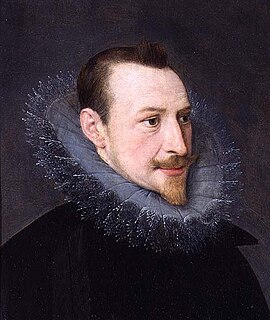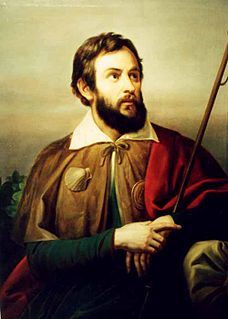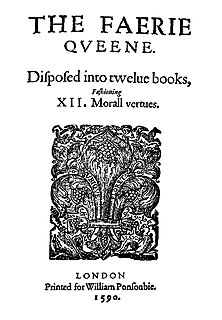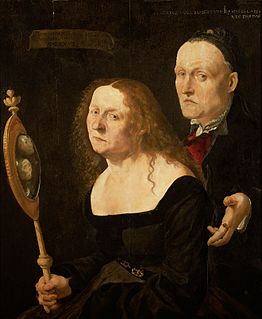
As a literary device, an allegory is a narrative in which a character, place, or event is used to deliver a broader message about real-world issues and occurrences. Authors have used allegory throughout history in all forms of art to illustrate or convey complex ideas and concepts in ways that are comprehensible or striking to its viewers, readers, or listeners.

A baldric is a belt worn over one shoulder that is typically used to carry a weapon or other implement such as a bugle or drum. The word may also refer to any belt in general, but this usage is poetic or archaic. In modern contexts, military drum majors usually wear a baldric.

Edmund Spenser was an English poet best known for The Faerie Queene, an epic poem and fantastical allegory celebrating the Tudor dynasty and Elizabeth I. He is recognized as one of the premier craftsmen of nascent Modern English verse and is often considered one of the greatest poets in the English language.

Ivanhoe: A Romance by Walter Scott is a historical novel published in three volumes, in 1819, as one of the Waverley novels. At the time it was written, the novel represented a shift by Scott away from writing novels set in Scotland in the fairly recent past to a more fanciful depiction of England in the Middle Ages. Ivanhoe proved to be one of the best-known and most influential of Scott's novels.

A fairy is a type of mythical being or legendary creature found in the folklore of multiple European cultures, a form of spirit, often described as metaphysical, supernatural, or preternatural.

A pilgrim is a traveler who is on a journey to a holy place. Typically, this is a physical journey to some place of special significance to the adherent of a particular religious belief system. In the spiritual literature of Christianity, the concept of pilgrim and pilgrimage may refer to the experience of life in the world or to the inner path of the spiritual aspirant from a state of wretchedness to a state of beatitude.

The Faerie Queene is an English epic poem by Edmund Spenser. Books I–III were first published in 1590, then republished in 1596 together with books IV–VI. The Faerie Queene is notable for its form: at over 36,000 lines and over 4,000 Stanzas it is one of the longest poems in the English language; it is also the work in which Spenser invented the verse form known as the Spenserian stanza. On a literal level, the poem follows several knights as a means to examine different virtues, and though the text is primarily an allegorical work, it can be read on several levels of allegory, including as praise of Queen Elizabeth I. In Spenser's "Letter of the Authors", he states that the entire epic poem is "cloudily enwrapped in Allegorical devices", and that the aim of publishing The Faerie Queene was to "fashion a gentleman or noble person in virtuous and gentle discipline".
Richard Barnfield was an English poet. His obscure though close relationship with William Shakespeare has long made him interesting to scholars. It has been suggested that he was the "rival poet" mentioned in Shakespeare's sonnets.

Thomas Warton was an English literary historian, critic, and poet. He was appointed Poet Laureate in 1785, following the death of William Whitehead (poet). He is sometimes called Thomas Warton the younger to distinguish him from his father Thomas Warton the elder. His most famous poem is The Pleasures of Melancholy, a representative work of the Graveyard poets.
Phineas Fletcher was an English poet, elder son of Dr Giles Fletcher, and brother of Giles the Younger. He was born at Cranbrook, Kent, and was baptized on 8 April 1582.

Eichstätt is a town in the federal state of Bavaria, Germany, and capital of the district of Eichstätt. It is located on the Altmühl river and has a population of around 13,000. Eichstätt is also the seat of the Roman Catholic Diocese of Eichstätt.

Eleanor of Austria, also called Eleanor of Castile, was born an Archduchess of Austria and Infanta of Castile from the House of Habsburg, and subsequently became Queen consort of Portugal (1518–1521) and of France (1530–1547). She also held the Duchy of Touraine (1547–1558) in dower. She is called "Leonor" in Spanish and Portuguese and "Eléonore" or "Aliénor" in French.

Hans Burgkmair the Elder (1473–1531) was a German painter and woodcut printmaker.

William Edward Frost was an English painter of the Victorian era. Virtually alone among English artists in the middle Victorian period, he devoted his practice to the portrayal of the female nude.
Orgoglio is a literary character in Edmund Spenser's famous epic The Faerie Queene. He appears in the seventh canto of Book One as a beast and attacks the main character, Redcrosse, who symbolizes the ultimate Christian knight, during a moment of weakness. "Orgoglio" means "pride" in Italian. In chapter IX of Waverley, by Sir Walter Scott, the manor of Bradwardyne is compared to the castle of Orgoglio.

Walsingham was a popular Elizabethan ballad tune. There are various versions of the lyrics, which relate to a pilgrimage site, suppressed during the English Reformation.

The Fairy Queen or Queen of the Fairies is a figure from Irish and British folklore, believed to rule the fairies. Based on Shakespeare's influence, in English-speaking cultures she is often named Titania or Mab.
The House of Pride is a notable setting in Edmund Spenser's epic poem The Faerie Queene. The actions of cantos IV and V in Book I take place there, and readers have associated the structure with several allegories pertinent to the poem.
The Political and Ecclesiastical Allegory of the First Book of the Faerie Queene is a book written by Frederick Morgan Padelford to explain the allegories within the poem The Faerie Queene by Edmund Spenser. The book was first published in 1911 in Boston by Ginn and Company as part of a series of University of Washington publications. The book has been republished since and is widely cited in papers and books related to the study of Spenser and his works.
Arthur Sutherland Pigott Woodhouse (1895–1964) was a Canadian professor of English at the University of Toronto, a leading authority on the works and times of the English Poet John Milton.














